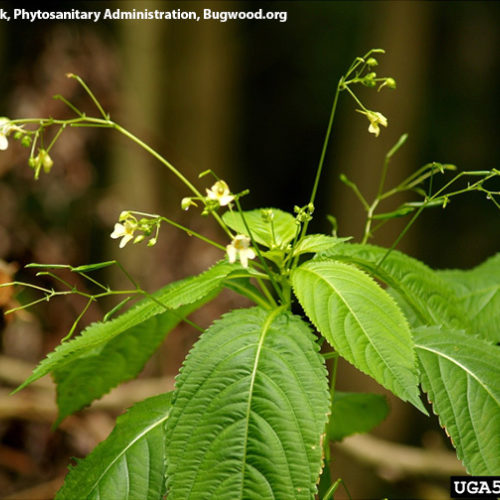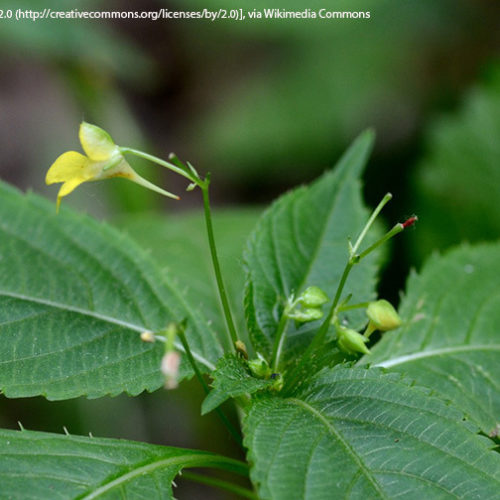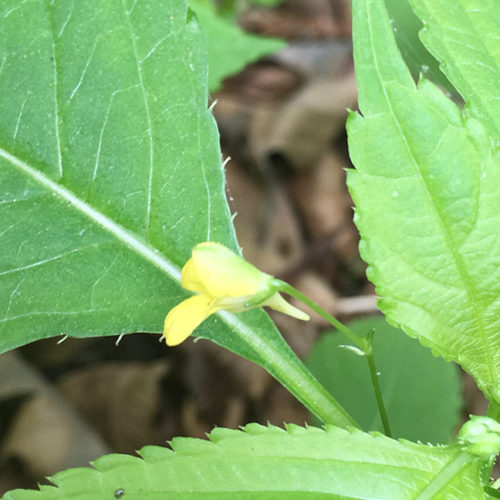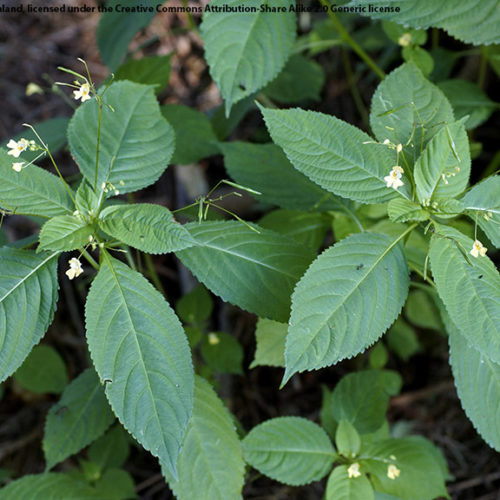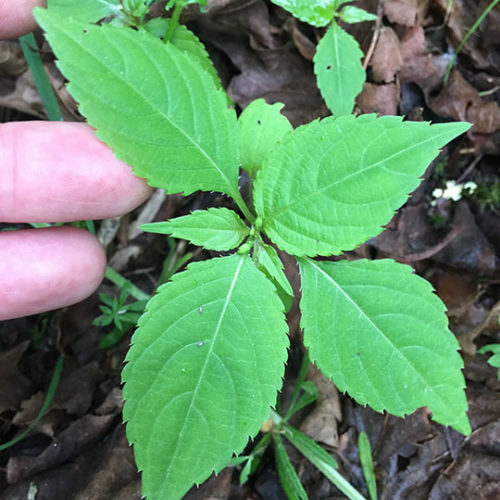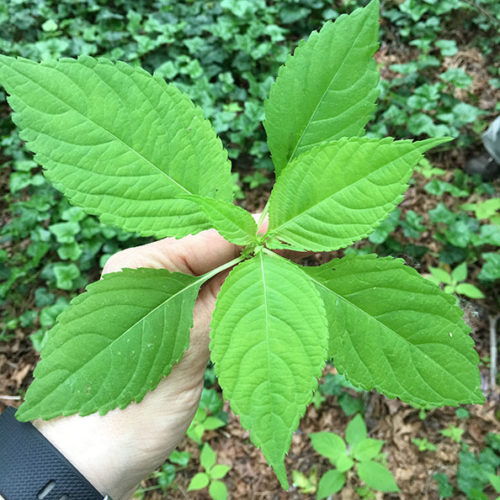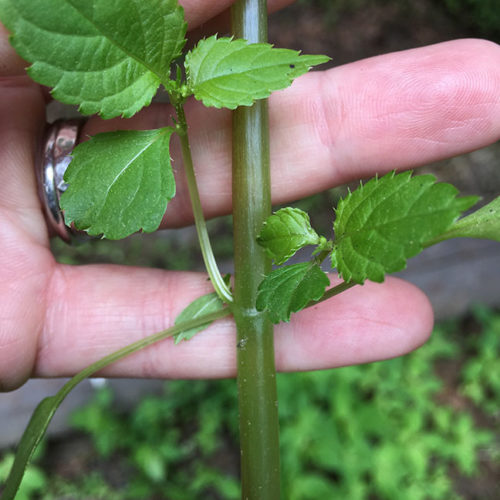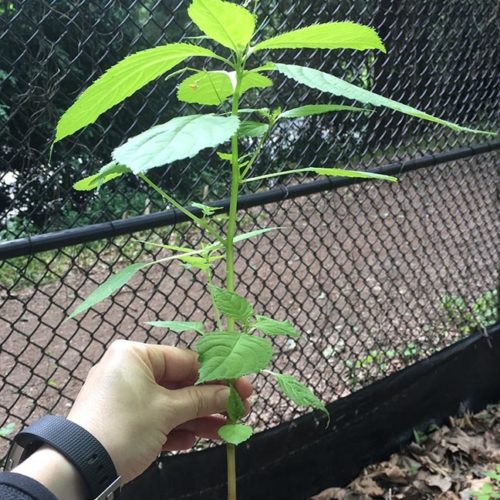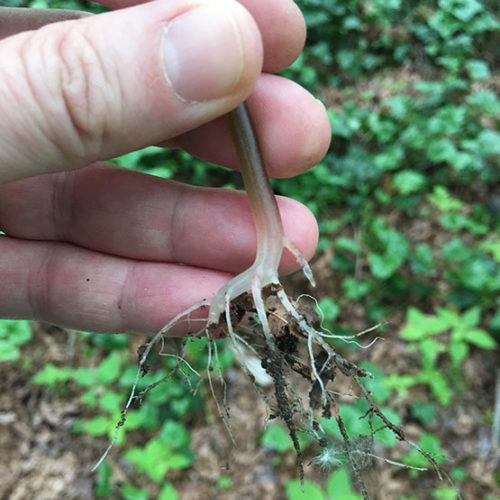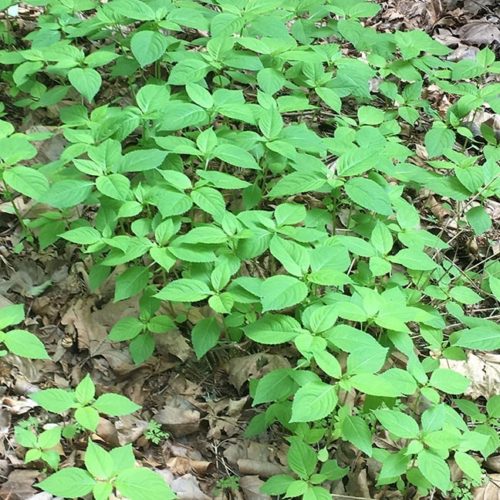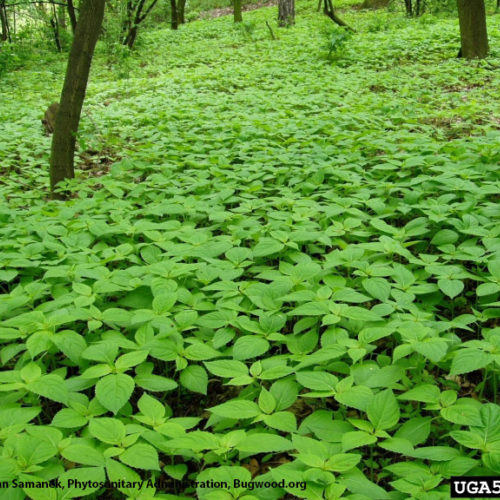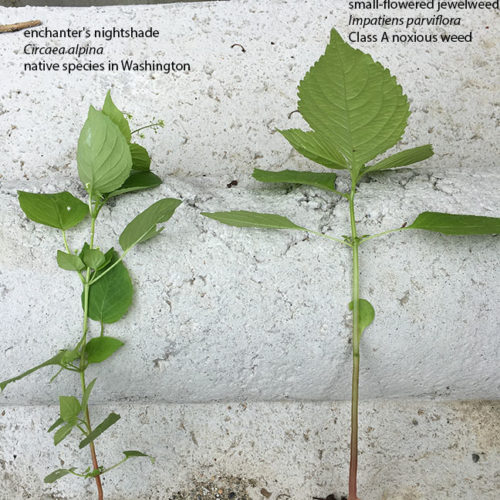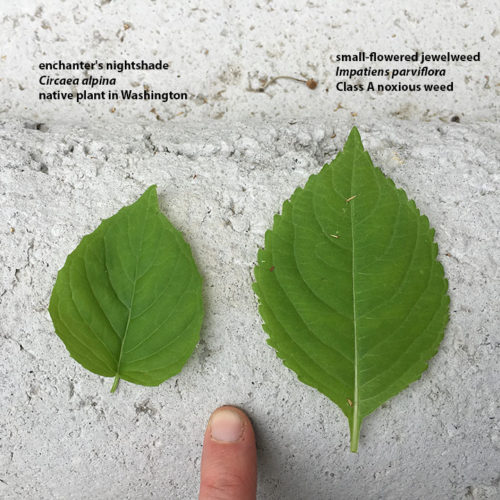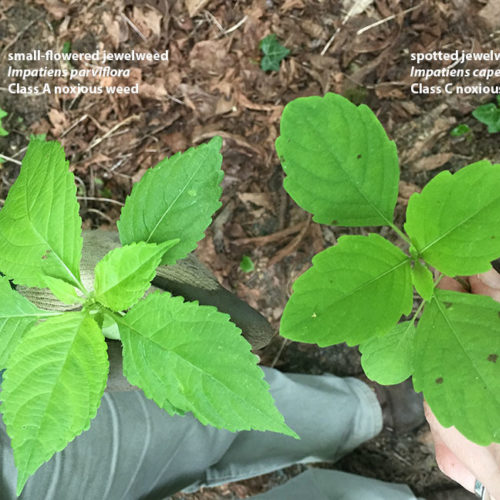Small-flowered Jewelweed
Impatiens parviflora
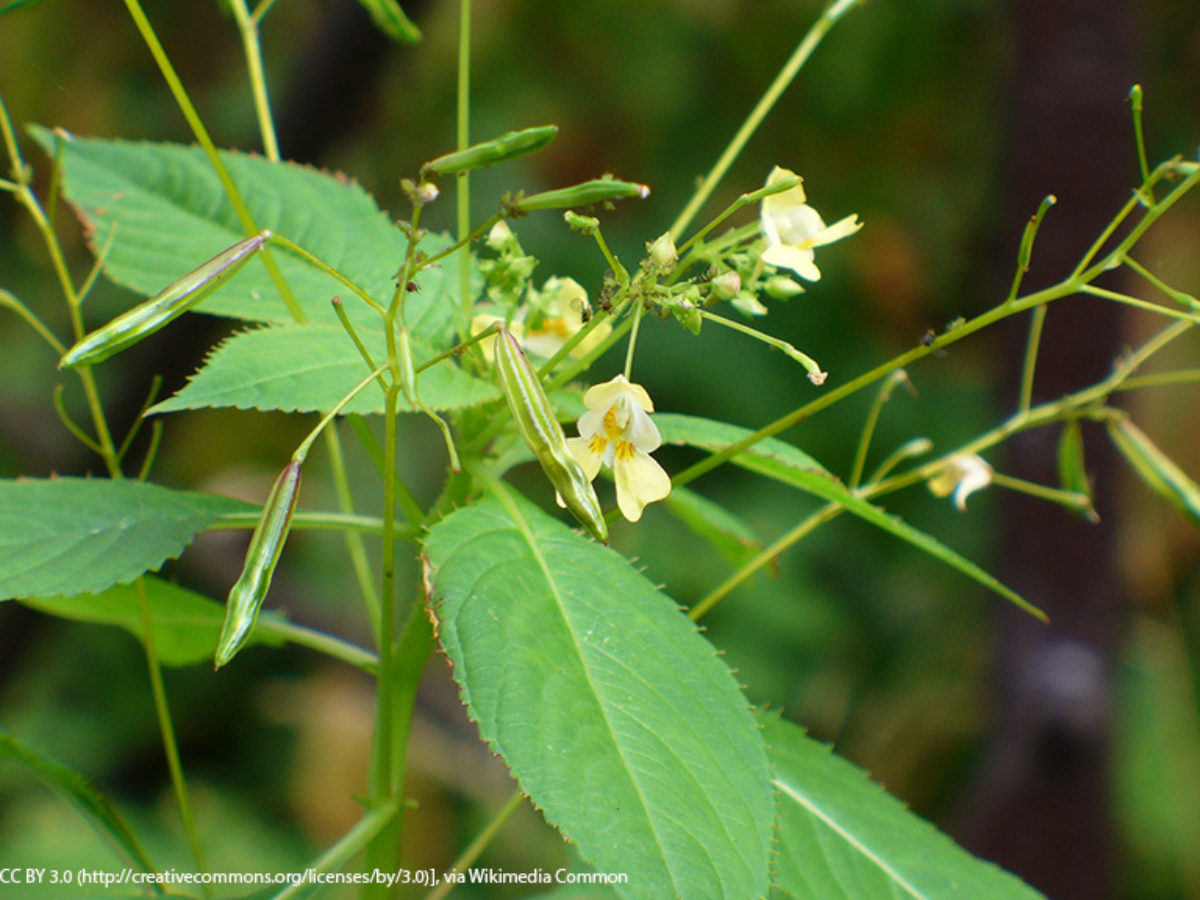
Family: Balsaminaceae
Other Scientific Names:
Impatiens nevskii Pobed.
Other Common Names: small-flowered touch-me-not, small balsam
Weed class: A
Year Listed: 2018
Native to: parts of Asia
Is this Weed Toxic?:
The genus of Impatiens contains napthoquinone, which may cause mild to moderate irritation of the digestive track.
Legal listings:
This plant is also on the Washington State quarantine list. It is prohibited to transport, buy, sell, offer for sale, or distribute plants or plant parts of quarantined species into or within the state of Washington or to sell, offer for sale, or distribute seed packets of seed, flower seed blends, or wildflower mixes of quarantined species into or within the state of Washington. Please see WAC 16-752 for more information on the quarantine list. For questions about the quarantine list, contact the Washington State Department of Agriculture's Plant Services Program at (360) 902-1874 or email PlantServices@agr.wa.gov.
Why Is It a Noxious Weed?
This is a new noxious weed for 2018. Small-flowered jewelweed is an annual that can invade and adapt to a variety of habitats. Plants can grow well under low light conditions as well as tolerate lower moisture conditions. Plants are able to dominate the herb layer of invaded forests, forming large, monospecific stands, displacing native species. Small-flowered jewelweed may have some allelopathic effects, results have been found in lab studies but it is unknown how these results relate to natural conditions.
How would I identify it?
General Description
Small-flowered jewelweed is an annual that is glabrous or with sparse stalked glands on upper plant parts. Plant height can vary greatly depending on growing conditions. Flowers are small, pale yellow and have a short, straight spur.
Flower Description
Small-flowered jewelweed inflorescences grow in the upper leaf axils and are typically comprised of 3 to 12
flowers. Plants can produce two types of flowers: cleistogamous flowers (do not open, self-fertilizing) and
chasmogamous flowers (open for cross pollination), which are showy and used for identification. The
early flowers are often cleistogamous. Chasmogamous flowers are 0.24 to 0.71 inches long, including the spur. Flowers are pale yellow, often having reddish spots in the throat. Flower spurs have a very small amount of nectar, much less than policeman's helmet, Impatiens glandulifera, another invasive Impatiens species.
Leaf description
Leaves are alternately arranged and have short petioles. Leaf blades are elliptic to ovate-elliptic, 1.6 to 7.9 inches long by 0.8 to 3.5 inches wide, the uppermost leaves typically the largest. Leaf base is wedge-shaped, tapering down the petiole and the leaf apex is acuminate (gradually tapering to a sharp point) or shortly acute. Leaf margins serrate or crenate-serrate, teeth directed forward, often with stalked glands near the base. Petioles may also have stalked glands.
Stem description
Stems are typically upright, succulent, growing up to 3 feet tall but can be shorter depending on environmental conditions. Stems simple or branched and having swollen nodes.
Fruit Seed Description
Small-flowered jewelweed produces capsules that are glabrous, linear-oblong, club-shaped or
cylindric, 0.4 to 1 inches long, and are pale green at maturity. Capsules produce 1 to 5 seeds that are oblong, 3 to 5 mm long, with longitudinal striations. Both types of flowers produce capsules with seeds. Capsules have 5
outer valves that coil rapidly during dehiscence, causing seeds in the capsule to be ejected when ripe.
May Be Confused With
There is an excellent key in the article: Botanical Electronic News with Impatiens article by Peter Zika (scroll down) along with a link to pictures that support the article. A table based on this article and other information can be found in our written findings, beginning on page 4.
Where does it grow?
Plants typically grow in shaded places with dry to moist soils. Habitats include: forests, forest clearings, forest edges or paths, riverbanks, lake shores, disturbed and cultivated sites and occasionally in open sites. Click here to see a county-level distribution of small-flowered jewelweed in Washington..
How Does it Reproduce?
Small-flowered jewelweed reproduces by seed. Capsules can explosively eject their seeds many feet when touched. Seed also float in water and are helped further by being carried on animals and birds, footwear, vehicle tires, and with timber.
How Do I Control It?
There is limited information available on control methods for small-flowered jewelweed. Control methods used for policeman’s helmet, Impatiens glandulifera, a Class B noxious weed in Washington, can be adapted for use on small-flowered jewelweed. Plants may have some seeds that remain in the seedbank after the first year so it is important to manage and monitor sites and provide additional control when necessary. Removing invasive species can open up a habitat to re-invasion if follow up management does not occur. By planting a variety of desirable species, a community will be present to help provide competition and shade weed seedlings and to also provide a food source for pollinators. When possible, carry out control methods when pollinators are not active on plants. Also, make sure to clean shoes, clothing, and equipment when leaving infested areas to prevent spreading seed to new locations.
Mechanical methods:
Small-flowered jewelweed has a shallow root system and can easily be hand-pulled when growing in damp soils. Make sure to remove the roots, especially in drier soils where plants may break off. If the plants do not have seed capsules, they can be crushed and left on site in a dry place to compost (King County Noxious Weed Control Program 2016--see link below). If plants have seed capsules, make sure to bag and put them in the trash (King County Noxious Weed Control Program 2016). It is important to properly identify plants before removal to avoid accidentally removing native Impatiens species. Plants will need to be identified while in bloom, and care needs to be taken as native Impatiens may grow among small-flowered jewelweed plants.
Cultural Methods:
Provide competition to small-flowered jewelweed by planting, seeding and promoting native plants in areas after control has taken place.
Biological Control:
There is currently no biological control agent used to control small-flowered jewelweed.
Response to Herbicides:
Large populations of small-flowered jewelweed may need chemical control for management. Make sure to survey populations before herbicide use to avoid treating native Impatiens species.
Small-flowered jewelweed is not currently included in The Pacific Northwest Weed Management Handbook, but check back as this resource is continually updated: https://pnwhandbooks.org/ . For questions about specific herbicide use, please contact your county noxious weed control board.
In general, use herbicide control in combination with other control methods to reduce usage when possible. When using a foliar spray, treat plants when pollinators are not present or are the least active.
For More Information
Draft written findings on Impatiens parviflora, small-flowered jewelweed
Botanical Electronic News with Impatiens article by Peter Zika (scroll down)
WTU image database information onImpatiens parviflora
King County Noxious Weed Control Program: management information for policeman's helmet. These methods can be used for small-flowered jewelweed.



